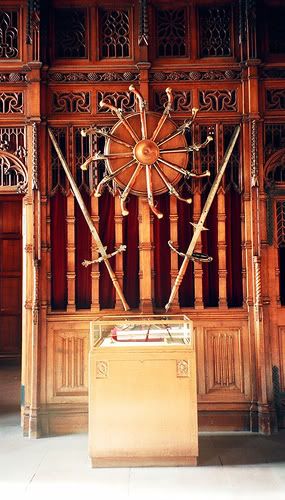That`s one beautiful and rare collection you have there!
Great to see, and I would love to see some even closer details on some of these.
Two handed swords have been used as procession swords for as long as they have been around. For official ceremony or parade, the two handed sword is a clear and mighty symbol of power, status and justice.
There is however a difference between two handed swords made exclusively for ceremony and those made first for practical use that may also have been used for ceremony.
From your photograph, all the swords shown there appear to be practical two handers, all crafted for practical martial use (and there`s a couple there that I bet fly nicely

)
It is possible that these have been used as processional swords at some stage in their life, but without contextual provenance, is impossible to prove.
Processional swords that are designed for ceremonial use firstly are evident by their form, dimensions or construction, which may all be outwith practical considerations and requirements.
Ceremonial Form -
The State Sword of Scotland is a good example of a sword hilt designed primarily for ceremonial use.

The blade is in fact a nicely forged and crafted piece that could be put to practical use if required, but the hilt is clearly ceremonial in nature.
All hilt elements are elaborately designed and covered in gilt work. The quillions are nicely formed, yet too thin for practical design. The grip is also metal and of a form not designed with comfort and effective grip in mind. The pommel is also overly large and hollow, which lends a greater canvas for the craftsman to present his skills, but is not so practical for any fighting sword.
Ceremonial Dimensions -
To create the impression of an ultimate symbol of power and status, some swords were created primarily for ceremonial impression.
The two handed sword presently on display at the Royal Museum of Scotland at Chambers Street, Edinburgh, is a fitting example of this (centre of image below).

This is a sword crafted in traditional form, but excessive dimensions.
Note the Highland two hander and Lowland two hander on each side. The Highland sword has a blade length of approx. 40", which by scale give the ceremonial sword an overall length well in excess of 80"!
This is one huge piece, with the blade as broad as your hand.
The sword is well made, with a nice blade in fact, but far too large for any practical use.
Ceremonial Construction -
In the Great Hall of Edinburgh Castle there are many swords. A great many original basket hilts and early sabres, one questionable Highland two hander, and two large pieces that at first glance appear to be nicely made German zweihanders.

The swords are of traditional form and dimensions, but closer inspection reveals their true nature.
The blades are excessively thick at the forte and down the length of the blade, indicating a blade weight outwith practical considerations. The grip and pommel are also carved from the same piece of wood. Aye, you heard it right, wooden pommels!
This confirms that these swords are created firstly to look the part, most likely for ceremonial use.
Another possibility exists, that these swords may have been created simply to look the part for a castle or stately home great hall in the C19th, given the gothic revival at this time. Only a closer study to period of manufacture could suggest further or otherwise.
With regard to ceremonial two handers however, I hope that the above observations might be helpful in your research.
All the best,
Macdonald